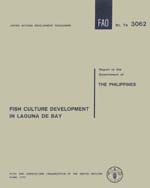
to the
GOVERNMENT OF THE PHILIPPINES
on
FISH CULTURE DEVELOPMENT IN LAGUNA DE BAY
| UNITED NATIONS DEVELOPMENT PROGRAMME PHI/71/3 | No. TA 3062 |
 | R E P O R T to the GOVERNMENT OF THE PHILIPPINES on FISH CULTURE DEVELOPMENT IN LAGUNA DE BAY |
based on the work of
Yoel Pruginin
FAO/TA Fish Culturist
FAO/UNITED NATIONS DEVELOPMENT PROGRAMME (TECHNICAL ASSISTANCE) REPORTS ON FISHERIES
This document is Report No. TA 3062 in the series of FAO reports produced under United Nations Development Programme (UNDP). Since 1 January 1966, reports produced under the former Expanded Programme of Technical Assistance (EPTA) have appeared in the UNDP (TA) series. The numbering of reports in the UNDP (TA) series is unbroken and follows consecutively the numbering of the former EPTA series.
Since 1 January 1962, those reports which concerned FAO technical assistance in fisheries have been numbered consecutively in a subseries within the general series.
The present report is the two hundred and twentyfirst report in the fishery subseries: FAO Fish.UNDP(TA)Rep., FIRI/UNDP(TA) 221.
For bibliographic purposes, this document may be cited as follows:
FAO. 1972 Report to the Government of the Philippines on fish culture development in Laguna de Bay. Based on the work of Yoel Pruginin, FAO/TA Fish Culturist. Rep.FAO/UNDP(TA), (3062):35 p.
FAO. Report to the Government of the Philippines on Fish Culture Development in Laguna de Bay, based on the work of Yoel Pruginin. Rome, 1972. 35 p. United Nations Development Programme, [Report] No. TA 3062. ABSTRACT The Laguna Lake Development Authority (LLDA) is a semi-public development agency of the Philippines Government, dedicated to planning and implementation of development plans of the Laguna de Bay region. That region includes the 90 000 ha Laguna Lake. The LLDA requested technical assistance in developing the lake fishery. This report concerns fish culture aspects of the overall fishery studies. The lake has been extensively studied in the past with respect to its fishery production and aquatic biota. A United Nations feasibility survey on multipurpose development of the lake for water supply, irrigation, land reclamation and fisheries was completed as a contractor study in December 1970 and is currently under review by the United Nations Office of Technical Co-operation. In general, the lake has been found to have high productivity for fish, estimated to be 0.4 t/ha. However, the existing species, which form the bulk of the lake catch, are small and of low market value. These do not represent a good combination to utilize the high level of natural fish food sources available in the lake. This report recommends that priority be given to development of fish culture
in the lake by means of pens, corrals and other lake water type enclosures. The
establishment of a fish hatchery and experimental station is found essential for
this type of development. The proposed station would produce fingerlings and
determine species combinations, rates of stocking, supplemental feed requirements,
design of the pen structures and other related problems. Potential economic
returns from 5 000 ha of lake enclosures for fish culture are estimated to yield
annually 10 000 t of fish and a net income of The LLDA has already initiated a programme for fishery development through
construction and operation of a 40 ha fish corral on the lake at Looc Cove. The
Authority is making arrangements for use of the Bay Fishery Station from the
Philippine Fisheries Commission as a hatchery and experimental station. An
FAO/UNDP Country Programme Project is proposed to assist in this development.
The project would extend over a three-year period, beginning in early 1972, at
an estimated cost of U.S. $229 400 and local costs of |
FOOD AND AGRICULTURE ORGANIZATION OF THE UNITED NATIONS
Rome, 1972
Hyperlinks to non-FAO Internet sites do not imply any official endorsement of or responsibility for the opinions, ideas, data or products presented at these locations, or guarantee the validity of the information provided. The sole purpose of links to non-FAO sites is to indicate further information available on related topics.
This electronic document has been scanned using optical character recognition (OCR) software. FAO declines all responsibility for any discrepancies that may exist between the present document and its original printed version.
1.1 Terms of Reference
1.2 Acknowledgements
1.3 Background Information on the LLDA
CHAPTER 2 BACKGROUND INFORMATION
2.1.1 United Nations feasibility survey for the hydraulic control of the Laguna de Bay complex and related development activities
2.1.2 FAO/UN, 1961; FAO/UN, 1962; Rabanal, Acosta and Delmendo, 1968, reports
2.1.3 Shimura and Delmendo
2.1.4 Laguna Lake Development Authority objectives and priority programme (dated 15 March 1971)
2.2.1 Physical characteristics
2.2.2 Ecology
2.2.3 Existing species
2.3 Existing Laguna de Bay Fishery Developments
2.3.1 Looc fish corral
2.3.2 Fish culture stations
2.3.3 Lake fishery
2.3.4 Fish ponds
2.3.5 Fish pens in Sampaloc Lake at San Pablo
2.4 Other Freshwater Fishery Developments visited in the Philippines
2.4.1 Candaba
2.4.2 Tarlac
2.4.3 Iloilo
CHAPTER 3 PROPOSED DEVELOPMENT PROGRAMME
3.1 Development Strategy
3.2 Fish Hatchery and Experimental Station
3.3 Fish Species
3.3.1 Starting combinations
3.3.2 Species for combination improvement
3.4.1 Fertilisers
3.4.2 Supplemental feeding
3.5 Fish Pen Concepts
3.6 Proposed East Bay Development
3.7 Development Goals
3.8 Socio-economic Implications
3.9 Procedure for Introduction of New Species
CHAPTER 4 REVIEW OF OTHER PROGRAMMES
4.1 United Nations Report Programme
4.1.1 Looc fish corral
4.1.2 Floating net cages
4.1.3 Lumban and East Bay development
4.1.4 Central Bay and stocking the lake
4.2 Preliminary LLDA Programme
4.2.1 Programme
4.2.2 Aquaculture
4.2.3 Organization of cooperatives
CHAPTER 5 LOCAL CAPABILITIES AND TRAINING
5.1 Availability of Technicians
5.2 Training Needs
5.3 Cooperation
CHAPTER 6 PROPOSED FAO/UNDP COUNTRY PROGRAMME PROJECT
6.1 Advance Programme
6.2 Country Programme
2. Map of Laguna de Bay Fishery and Other Projects
3. Map of East Bay Fishery Development
4. Diagram of Proposed Bay Station Development
1. LLDA PRELIMINARY PLAN OF WORK ON INTENSIVE FISHERIES RESEARCH AND DEVELOPMENT
2. PROPOSED FAO/UNDP COUNTRY PROGRAMME PROJECT